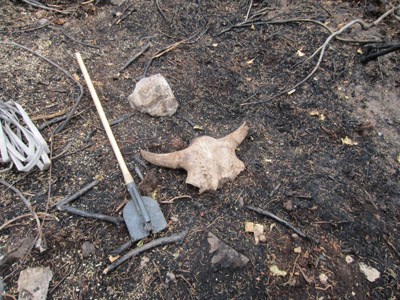Last updated: November 2, 2017
Article
Bison Bellows: Recent Evidence of Bison at Glacier National Park

Photo courtesy of Mark J. Biel.
Of all the megafauna species that inhabited Glacier National Park's landscape in northwest Montana in the early 19th century, the American bison and pronghorn antelope are thought to be the only species currently missing. There is historic evidence that bison used the park's extant east-side (i.e., east of the Continental Divide) prairie tongues, at least seasonally. There is also evidence of prehistoric bison kill sites in at least six drainages on the east side of the park. These sites occurred where communal hunting strategies were employed to drive bison into traps (e.g. corrals, wetlands, or snow drifts), where they were then killed. Recently, several new discoveries have expanded our understanding of bison presence and distribution in the park. In 2015, at least 14 individual sites associated with bison (in the form of bison bones and/or skulls) were documented in the St. Mary Valley following a wildfire. A bison skull was located obtruding from a melting glacial ice patch near Otokomi Lake that was carbon-dated to 967+ years BP. Further analysis of the carbon found in the bones suggested that this particular bison had been eating primarily plant matter found in the alpine and subalpine biological zones, indicating that this bison had spent a significant portion of its life living at higher elevations, and not on the plains. An additional partial bison skeleton was recently documented eroding from a cut bank in the Belly River drainage of the park that will also be carbon dated and examined for its type of diet.
In the past, park managers have cautiously supported the return of bison as free-ranging wildlife, while also acknowledging concerns about invasive vegetation, herd abundance and management, genetics, competition with cattle or other large herbivores. Restoration of bison could contribute to a more natural predator-prey dynamics and integrity of the park's grassland ecosystems. Recently, the park met with representatives from the Blackfeet Tribe to discuss the reestablishment of a "wild," free-ranging bison herd on Tribal lands in the Badger-Two Medicine and Chief Mountain areas. The idea of returning bison to this landscape is compelling from many perspectives, including conservation biology and cultural connectivity. It is also a good fit with the nature-based economy model developed by the Blackfeet Tribe. Park officials have agreed to work with Tribes, First Nations, Parks Canada, and conservation partners to develop a shared strategic vision for restoration of this important natural and cultural icon on an international transboundary landscape scale.
